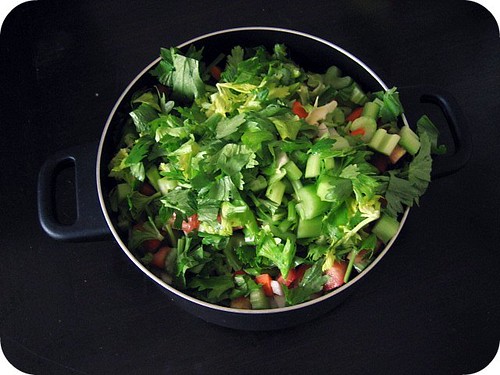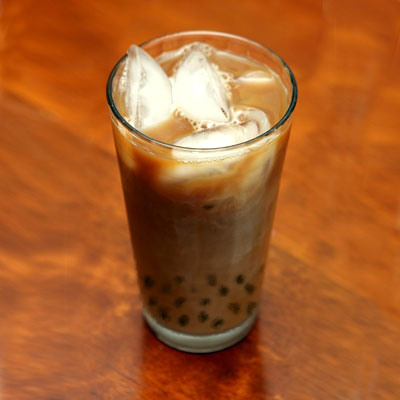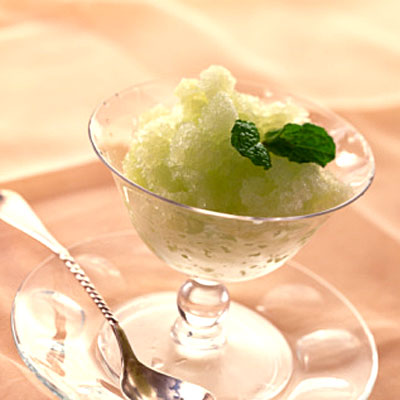Ingredients
- 1 long European cucumber or 2 regular cucumbers, peeled if waxed
- Salt to taste
- 1 cup small-curd low-fat cottage cheese
- 2 cups low-fat plain Greek-style yogurt
- Lots of freshly ground pepper
Preparation
1. If using regular cucumbers, cut in half lengthwise. Scoop out the seeds. Dice very small (1/4 inch or smaller). If using a European cucumber, you don’t need to peel. Optional: sprinkle with salt and allow to drain for 15 minutes in a colander. Draining is not necessary if you don’t use salt; if you do, draining will prevent the dish from becoming watery later.
2. In a food processor, blend together the cottage cheese and yogurt until smooth. (Alternatively, put the cottage cheese through a fine strainer and whisk with the yogurt.) Transfer to a bowl. The mixture should have a creamy consistency. Stir in the cucumber and lots of pepper. Taste and adjust seasoning. Chill until ready to serve. Serve with toasted bread or as a salad.
Yield: Serves six.
Ingredients
- 4 medium cucumbers, peeled if waxed, or 2 European cucumbers
- 1 tablespoon canola oil or extra virgin olive oil
- 1 small onion, cut in half lengthwise, then sliced across the grain
- Salt and freshly ground pepper
- 1 teaspoon curry powder (more to taste)
- 1/2 cup dry white wine
- 1 tablespoon chopped fresh chives or cilantro
Preparation
1. If using regular cucumbers, cut in half lengthwise and scoop out the seeds. Slice on the diagonal about 1/4 inch thick. If using long European cucumbers, peel, if desired, and slice on the diagonal about 1/4 inch thick.
2. Heat the oil in a large lidded skillet or saucepan over medium heat, and add the onion. Cook, stirring, until tender, about five minutes. Add a pinch of salt and the curry powder, and stir together for another minute. Add the cucumber, and cook, stirring, for three minutes. Stir in the wine, and bring to a simmer. Cover, reduce the heat and simmer 15 minutes. Uncover, raise the heat and cook until the liquid evaporates. Season to taste with salt, remove from the heat and stir in the chives or cilantro. Serve hot, at room temperature or cold.
Yield: Serves four to six.
Ingredients
- 3 Persian cucumbers, or 1 long European cucumber (or if neither is available, 2 regular cucumbers)
- 1 pound ripe tomatoes
- 2 tablespoons fresh lime juice
- Salt to taste
- 1 garlic clove, mashed to a puree with 1/4 teaspoon salt
- Freshly ground pepper
- 1/4 cup extra virgin olive oil
- 2 scallions, chopped
- 4 radishes, thinly sliced
- 1 cup chopped flat-leaf parsley
- 1/4 cup chopped fresh mint
- 1/4 cup chopped cilantro
Preparation
1. If using seedless cucumbers (Persian or European), cut in 3/4-inch dice. If using regular cucumbers, peel, if waxed, and cut in half lengthwise. Using a small spoon, scrape out the seeds and discard. Cut the cucumbers into 3/4-inch dice. Place in a large bowl with the tomatoes.
2. Whisk together the lime juice, garlic, pepper and olive oil. Toss with the cucumbers and tomatoes. Add the remaining ingredients, and toss everything together thoroughly. Taste, adjust seasonings and serve.
Yield: Serves four.
Ingredients
- 2 medium cucumbers, peeled if waxed, or 1 European seedless cucumber
- 3 tablespoons chopped fresh dill
- Salt and freshly ground pepper
- 1 1/2 pounds Pacific halibut fillets or sand dabs
- 2 large garlic cloves, minced
- 1 or 2 shallots, minced (optional)
- 1/4 cup fresh lemon juice
- 1 tablespoon extra virgin olive oil
- 1/4 cup dry white wine
Preparation
1. Preheat the oven to 425 degrees. If using regular cucumbers, cut in half lengthwise, scoop out the seeds and slice thin. If using a European cucumber, just slice thin. Oil a baking dish large enough to accommodate the fish fillets in one layer. Cut a piece of parchment the size of the baking dish, and set it aside. Line the baking dish with half of the cucumber slices. Sprinkle on 1 tablespoon of the dill and salt and pepper lightly.
2. Rinse the fish fillets, and pat dry. With the tip of a sharp knife, score them on the diagonal a few times (this prevents them from curling when they cook). Lay on top of the cucumbers. Salt and pepper lightly, and sprinkle on the garlic and shallot. Sprinkle with another tablespoon of the dill, and drizzle on half the lemon juice and the olive oil. Top with the remaining cucumbers. Add the remaining lemon juice, and sprinkle the remaining dill over the top layer of cucumbers. Add the white wine, and cover with the parchment. Cover the dish tightly with foil, and place in the oven. Bake 10 to 15 minutes until the fish is opaque and pulls apart when stuck with a fork.
3. Remove from the oven, let sit for a few minutes and then serve from the baking dish, spooning some of the liquid from the baking dish over the top.
Yield: Serves four.
Ingredients
- 1 1/2 pounds cucumbers, peeled if waxed and sliced very thin
- 3 tablespoons champagne vinegar
- 1/2 teaspoon Dijon mustard (more to taste)
- Salt and freshly ground pepper
- 1/4 cup canola oil
- 2 tablespoons extra virgin olive oil
- Optional: finely chopped fresh parsley, dill or chives
- 1 shallot, minced
Preparation
1. If using regular cucumbers, cut in half lengthwise and scoop out the seeds with a small spoon. Slice paper-thin. (English cucumbers and Persian cucumbers can just be sliced paper-thin without removing the seeds.) Place the cucumbers in a bowl.
2. In a small bowl or measuring cup, combine the vinegar, mustard, salt and pepper and whisk together. Whisk in the canola oil and the olive oil. Toss with the cucumbers, along with any of the optional ingredients. Taste and adjust seasonings. Serve right away, or refrigerate for up to 30 minutes and serve.
Yield: Serves six.
Source:
New York Times
Home Care Assistance offers the highest quality 24/7 live-in home care in the
Region of Halton (
Oakville,
Burlington,
Halton Hills, and
Milton),
Region of Peel (
Mississauga,
Brampton and
Caledon) and
Hamilton.





























